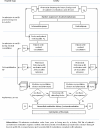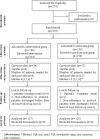A multicentre, double-blind, randomised, controlled, parallel-group study of the effectiveness of a pharmacist-acquired medication history in an emergency department
- PMID: 23984830
- PMCID: PMC3844415
- DOI: 10.1186/1472-6963-13-337
A multicentre, double-blind, randomised, controlled, parallel-group study of the effectiveness of a pharmacist-acquired medication history in an emergency department
Abstract
Background: Admission to an emergency department (ED) is a key vulnerable moment when patients are at increased risk of medication discrepancies and medication histories are an effective way of ensuring that fewer errors are made. This study measured whether a pharmacist-acquired medication history in an ED focusing on a patient's current home medication regimen, and available to be used by a doctor when consulting in the ED, would reduce the number of patients having at least 1 medication discrepancy related to home medication.
Methods: This multicentre, double-blind, randomised, controlled parallel-group study was conducted at 3 large teaching hospitals. Two hundred and seventy participants were randomly allocated to an intervention (n = 134) or a standard care (n = 136) arm. All consecutive patients >18 years old admitted through the ED were eligible. The intervention consisted of pharmacists conducting a standardised comprehensive medication history interview focusing on a patient's current home medication regimen, prior to being seen by a doctor. Data recorded on the admission medication order form was available to be used by a doctor during consultation in the ED. The admission medication order form was given to doctors at a later stage in the control arm for them to amend prescriptions. The effect of the intervention was assessed primarily by comparing the number of patients having at least 1 admission medication discrepancy regarding medication being taken at home. Secondary outcomes concerned the characteristics and clinical severity of such medication discrepancies.
Results: The intervention reduced discrepancies occurring by 33% (p < 0.0001; 0.1055 odds ratio, 0.05-0.24 95% confidence interval), despite recall bias. Regarding total discrepancies, omitting medication occurred most frequently (55.1%) and most discrepancies (42.7%) were judged to have the potential to cause moderate discomfort or clinical deterioration.
Conclusions: A pharmacist-acquired medication history in an ED focusing on a patient's current home medication regimen available to be used by a doctor at the time of consulting in the ED reduced the number of patients having at least 1 home medication-related discrepancy.
Trial registration: Current Controlled Trials ISRCTN63455839.
Figures
References
-
- Slee A, Farrar K, Hughes D, Constable S. Optimising medical treatment - how pharmacist-acquired medication histories have a positive impact on patient care. Pharm J. 2006;277:3.
-
- Cornish PL, Knowles SR, Marchesano R, Tam V, Shadowitz S, Juurlink DN, Etchells EE. Unintended medication discrepancies at the time of hospital admission. Arch Intern Med. 2005;165:424–429. edn. United States. - PubMed
-
- Beers MH, Munekata M, Storrie M. The accuracy of medication histories in the hospital medical records of elderly persons. J Am Geriatr Soc. 1990;38(11):1183–1187. - PubMed
-
- Kwan Y, Fernandes OA, Nagge JJ, Wong GG, Huh JH, Hurn DA, Pond GR, Bajcar JM. Pharmacist medication assessments in a surgical preadmission clinic. Arch Intern Med. 2007;167:1034–1040. United States. - PubMed
-
- Carter MK, Allin DM, Scott LA, Grauer D. Pharmacist-acquired medication histories in a university hospital emergency department. Am J Health Syst Pharm. 2006;63:2500–2503. United States. - PubMed
Publication types
MeSH terms
Associated data
LinkOut - more resources
Full Text Sources
Other Literature Sources
Medical



